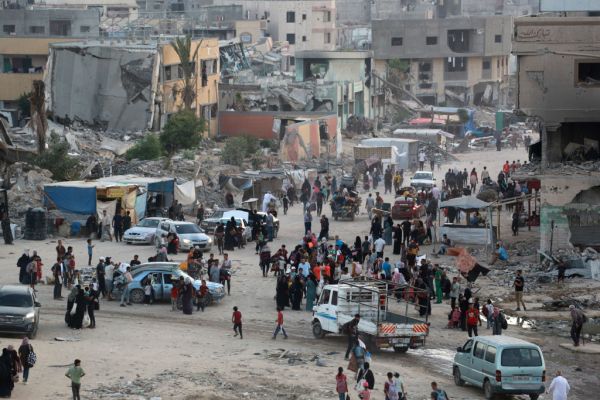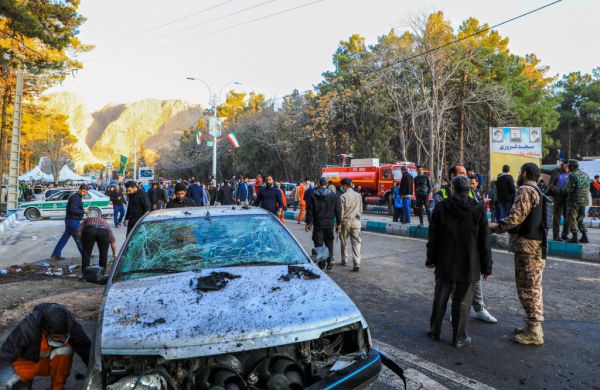STERLING, Virginia—Nazia Hashimyar stared into the camera from behind a blue and white news desk Wednesday, the words “Amu News” written in Farsi on an LED background behind her.* In a moment, her image and voice would be transmitted into her home country of Afghanistan for Amu TV’s first satellite broadcast.
It was a moment of hope, but one born of significant loss.
Female journalists can’t report safely from within Afghanistan, but Hashimyar will be an anchor for start-up news outlet, Amu TV, headquartered in Sterling, Virginia. Its purpose is to offer a lifeline of credible news and information for Afghans starved of information not strictly censored by the Taliban. Exiled Afghan journalists Lotfullah Najafizada and Sami Mahdi founded the network last August. Its online news outlet offers coverage in Farsi, Pashto, and English, its target audience is those within the country, and 75 percent of its readership is Afghan.
Since Amu TV launched online last year, it’s had over 100 million pageviews. Najafizada and Mahdi hope the satellite channel, launched Wednesday, will take that engagement even further: Satellite TV is the most popular source of information for people in Afghanistan, especially in rural areas where internet access is scarce.
Funded by grants and private donations, the channel now employs some of the most recognizable personalities in Afghan’s media landscape who rose to prominence prior to the Taliban’s decimation of the country’s media and entertainment industry.
Before leaving the country, Najafizada directed Afghanistan’s most prominent media network, TOLOnews, in Kabul. Mahdi, Amu TV’s editor-in-chief, was the bureau chief of Radio Azadi and a professor at Kabul University.

Hashimyar fled Afghanistan on September 23, 2021, a month after the Taliban’s August takeover, leaving her family behind.
“I was alone and you know, I left everything behind,” she told The Dispatch Tuesday. “My family and my country. I lost everything.”
She had two reasons to fear Taliban targeting: as a female news anchor and as a former communications president with the former Afghan government.
After spending a year in a refugee camp in Abu Dhabi, Hashimyar came to the U.S. on a refugee visa last September. She’s found a home reporting and anchoring for Amu TV.
Within the country, reporters are forbidden from covering protests or criticizing the Taliban. But headlines under the “Women” subsection of Amu TV do plenty of both: “Women protesters in Islamabad warn against any attempt to recognize Taliban,” “Two women ‘beaten’ by Taliban member in Bamiyan,” and “Another blow to women in Herat as Taliban ban them from visiting historical sites.”
“One of the most important things for me for now is the woman topic in Afghanistan,” Hashimyar said.
The U.S. newsroom has fewer than a dozen journalists, but other reporters work from Canada, Europe, and parts of the Middle East, including Afghanistan, bringing the total staff to around 50.
To protect journalists still on the ground, many of the bylines on the website go to “Amu TV” rather than specific reporters. The journalists in Afghanistan primarily send raw material—footage and background information—to colleagues abroad, who do in-person reporting elsewhere.
Censorship of media is now state policy in Afghanistan: Taliban supreme leader mullah Haibatullah Akhundzada in a decree said that “defaming and criticizing government officials without proof” and “spreading false news and rumors” was against Islam. The Taliban read broadcast scripts ahead of time and tell reporters what questions they can and can’t ask in interviews, and have ordered women news presenters to cover their faces.
In the first 12 months after the Taliban’s takeover, nearly 40 percent of the media outlets in the country closed, and nearly 60 percent of journalists lost their jobs, with over 75 percent of women journalists losing their jobs, according to a 2022 Reporters without Borders report.
“After the collapse of Kabul, the regime changed. Our values of reporting and journalism didn’t change,” Mahdi said.
Amu TV plans to expand beyond just news and into current affairs, entertainment, and educational programs. Every evening, from 6 p.m. to midnight, Amu TV will offer six hours of original content.
Enter Mujeeb Arez, whom Mahdi said is “probably one of the most famous faces in Afghanistan, in the entertainment domain.” Arez was a child star and by his early 20s he was hosting (and scripting and producing) a popular show, called On the Road. The reality-TV style show was partially funded by (United States Agency for International Development) U.S.A.I.D.
When the Taliban invaded, Arez was working at the country’s most successful media network, which produced dramas, soap operas, talent competitions, and other programming. He was able to evacuate with his wife in August 2021, but still worries about friends left behind.
He’s now the head of production at Amu TV. He also runs his own show, which he said averages around 100,000 online views per episode, and focuses on interviewing Afghans and highlighting inspiring stories. He plans to bring similar content to Amu TV’s satellite broadcasts.
“The goal we have—that gives us motivation and energy—which is to entertain people and the connection we have with our people, we want to maintain that,” Arez said. “We need to give people, the audience, entertainment. At the same time educate them, and show them good role models that can inspire.”
Afghan kids, for instance, are only seeing Taliban members on state-controlled media. “What do you think, 10 years later, he will become, she will become?”
Wednesday’s first live satellite broadcast finished in 30 minutes. Other programming included prerecorded interviews, dramas, and music shows. Stories covered included recognizing World Press Freedom Day, an interview with U.S. Charge d’Affaires for Afghanistan Karen Decker, and the Taliban’s abuse of a gold mine in Northeastern Afghanistan.
When Hashimyar, and a handful of other team members emerged from the studio, they were greeted with applause from a crowd of fellow Afghan refugees and other supporters gathered in the office.
“As you are aware, media in Afghanistan is totally changed now,” Arez said through tears when invited by Mahdi to give a short speech to the room. “So I hope me, with my colleagues, we can give them some hope from here.”
Correction, May 4, 2023: “Amu News” is written on a screen behind the news desk, not “Amu TV,” as this story originally said due to an editing error.










Please note that we at The Dispatch hold ourselves, our work, and our commenters to a higher standard than other places on the internet. We welcome comments that foster genuine debate or discussion—including comments critical of us or our work—but responses that include ad hominem attacks on fellow Dispatch members or are intended to stoke fear and anger may be moderated.